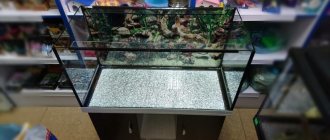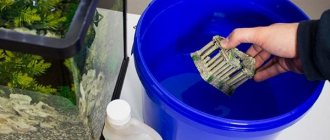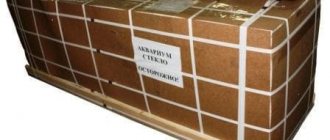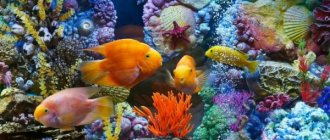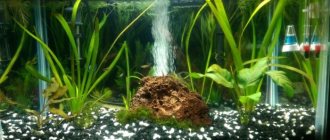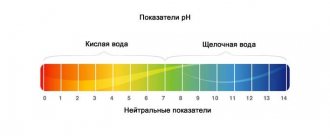There are an endless variety of liquid and powder supplements available in stores to help you get your aquarium up and running. Here we'll look at some of the most important ones and discuss what they do, how they work, and how to use them properly.
Water conditioners
Aquarium water conditioner is perhaps the most basic of all additives. They are used throughout the aquarium hobby. The main purpose of water conditioners is to remove or neutralize toxic and harmful substances contained in tap water. Don't worry, your tap water is perfectly drinkable, but keep in mind, your fish need to live and breathe in it. Tap water is treated using methods that kill and remove unwanted organisms that live in it, namely bacteria and viruses that can make people sick. Chemicals such as chlorine and chloramines are introduced at water treatment plants. If left in the water, the fish's sensitive gills will be damaged, causing your fish to suffocate and eventually die. You should find out what type of sterilization your municipality uses to disinfect your local water supply and select a water conditioner that neutralizes the relevant chemical elements.
Many aquarium water conditioners also remove heavy metals, which are found in low concentrations in tap water. These substances tend to accumulate in higher concentrations in the aquarium and therefore detoxifying them is necessary to keep your aquarium healthy in the long term. Conditioners that are specifically designed to detoxify heavy metals such as Sera Aquatan, Kordon Novaqua Plus and Tetra AquaSafe.
There are also a number of conditioners designed specifically to detoxify fish waste; They are used primarily in emergency situations when something has gone wrong in the aquarium and the ammonia and nitrites have risen to dangerous levels. They are also quite useful when shipping or transporting fish, as they prevent ammonia poisoning in small volumes of the container used to transport fish. Products in this category include - Kordon Amquel Plus, Tetra Ammonia Detox, Sera Toxivec and Gulfstream Ammonia-Ease.
Lastly, water conditioners often contain additives to help your fish fight infections and stay healthy by strengthening their natural "protective mucus" using ingredients such as aloe vera. These products include API Stress Coat+ and TetraAqua Vital. The use of water conditioners is not necessary if you have a high level of water purification or a system such as reverse osmosis. Be aware that the use of "protective mucus" water conditioners can cause problems in saltwater aquariums that use protein skimmers.
How often should you clean your aquarium?
You can understand that it’s time to wash the aquarium based on the results of a water test for nitrates and ammonia or based on external factors. If the aquarium is dirty, then you will see with your own eyes mud clouds rising from the substrate, growths on the walls, etc.
The frequency of cleaning the aquarium depends on its volume, the number of fish and plants living in it. On average, the cleaning procedure is performed 1–2 times a week.
How often should you siphon the soil in an aquarium?
The causes of soil contamination are fish waste products and food residues from feeding. Clearing the soil is a labor-intensive process, which is not necessary unless necessary.
The right time for the procedure can be determined by the unpleasant smell of rotten eggs that rose with the help of bubbles when turning the pebbles. The smell is caused by hydrogen sulfide gas, which can make fish sick and, in severe cases, die.
Cleaning should be carried out at least 2 times a month.
How often to wash the external filter in an aquarium
The filter purifies the liquid and accumulates beneficial microorganisms in it, which accumulate on external parts. Frequently washing the filters will destroy the beneficial bacteria necessary for an active and healthy life for your fish. Therefore, cleaning the filter should not be done more than once a month. The components can be replaced or rinsed, depending on the design of the model.
Biological Additives
Concentrated bacterial enzyme biological additives or additives that are added to improve or enhance biological filtration and to eliminate and/or reduce fish waste. There are many different types of dietary supplements made by different manufacturers; however, there are two main types of dietary supplements with three different purposes.
The first type of biological additive is the one you will most likely purchase when you first start your aquarium. They are designed to begin biological filtration in a newly installed aquarium. A biological filter is a component of a filtration system or home to bacteria responsible for the breakdown of fish waste; This is the most important type of filtration and these additives provide a bacterial starter to help colonize the biological filter with beneficial bacteria. They allow the biological balance in the aquarium to be established faster. Examples of these products are Hagen Nutrafin Cycle, TetraAqua Bactozym, Seachem Stability, TetraAqua SafeStart, Sera Filter Biostart and Marc Weiss Bacter Vital.
This first type of supplement is important for the long-term health of your aquarium. Over time, only one or two strains of bacteria will dominate the aquarium. Variety helps the filter do a better job, thus introducing different strains of bacteria and resulting in a healthy aquarium. In addition, many aquarists, when performing routine maintenance, often damage the biological balance by rinsing the bio-filter components of their filtration system under running water or removing too much old water in one change. These additives help restore the bio-filter by preventing ammonia and nitrite outbreaks and preventing fish stress. All the drugs mentioned above can be used for this purpose, but API (Aquarium Pharmaceuticals) and Tetra have developed Stress Zyme and TetraAqua Biocoryn, TetraAqua EasyBalance specifically to solve this problem.
The second type of biological additive is a means for decomposing organic matter. These products help quickly break down accumulated waste and/or detritus that accumulates in the aquarium over time. They are made either from biologically active enzymes or chemicals that oxidize waste. They chemically break down waste into simpler molecules, which are converted into nitrates by bacteria. They must be used with caution, processing large amounts of waste at once can release ammonia and cause stress to your fish. However, they can be an effective means of reducing the loss of bio-components in your aquarium. Examples of such products include TetraAqua NitrateMinus ,
Hagen Nutrafin Waste Control, Sera Bio Nitrivec, Kent Poly-Ox and SuperBac Biological Aquarium Cleaner. It is recommended that these products be used with the first type of bio-additive to help manage the additional ammonia emissions.
How to clean an aquarium from white limescale deposits
White limescale is the remains of mineral salts deposited on the surface of the glass as a result of evaporation of the liquid.
Methods for cleaning white deposits in an aquarium:
- Mechanical cleaning. Using a scraper, toothbrush, or the hard side of a sponge.
- Special glass cleaning products (sprays and wipes).
- Folk remedies (citric acid, ammonia, etc.).
Water Purifiers
The clarity of your aquarium water has an impact on the appearance of your aquarium. Crystal clear water in an immaculately clean aquarium creates a stunning picture with or without fish! Products in this category include - Kent Pro-Clear, TetraAqua CrystalWater, Seachem Clarity, Sera Aquariaclear and API Accu-Clear.
Often when changing the water, servicing your filtration system, or cleaning algae from glass, aquarium water becomes cloudy. This can be a problem, especially if you cleaned the aquarium because you are having a dinner party that evening and wanted your aquarium to be special! Many aquarists use water purifiers every time they make a change, just to avoid the inevitable 12-24 hour cloudiness. In addition, new aquariums often become cloudy; this is normal and you should not try to use these cleaners.
Most purifiers are suitable for either fresh or salt water, so check before using. In addition, it is better to use cleaners in a clean aquarium (washed gravel) and not too dirty, the effect will be more pronounced. This is because these drugs work by binding small particles in water together into larger ones and sedimenting them out. Finally, it is important to monitor the carbonate hardness of your aquarium, especially if you have soft aquarium water, as these drugs can lower the KH, which can lead to a pH balance problem; This is quite rare and generally no need to worry about it.
How to clean an aquarium
Special means
These are specially developed cleaning products, after use of which you need to completely wash off the remaining particles so as not to harm the inhabitants.
Examples of cleaning products:
- wipes with impregnation to dissolve lime and green deposits;
- spray for cleaning glass from calcification;
- filter softener that reduces the level of hardness, etc.
To use the above products, it is recommended to completely empty the aquarium and, in the case of the latter, to use it for a short period of time.
Folk remedies
In the event that there are no special cleaning products at hand, an alternative replacement with products available on the farm is possible:
- Baking soda is the most famous cleaning agent.
- Vinegar (9%) copes with white plaque. A tablespoon of vinegar per 200 grams of water.
- Wine vinegar will replace glass cleaner. A spoonful of vinegar dissolves in a glass of water, leaves no streaks and quickly removes plaque.
- Citric acid is effective against calcium deposits. 20 grams of powder are diluted in a glass of water.
- Ammonia is also used for decalcification. Diluted in a ratio of 1:10.
- Hydrogen peroxide is another effective option. The substance is diluted in a ratio of 1:15. Peroxide will help in case of rapid spread of algae, filter malfunction, etc. It allows you to saturate the water with oxygen and oxidize the resulting organic matter. The solution is sprayed in a thin stream into the filter, which will gradually release it into the water. After about an hour, the water is changed to remove dead organic matter.
To use liquid solutions, it is most convenient to use spray bottles.
What products are not recommended for cleaning an aquarium?
It is not recommended to use regular glass cleaners as they contain ammonia, which is toxic to fish, as well as regular cleaning agents. As in the case of special and folk remedies, this is caused by the likelihood that residues of the product will remain on the surface. Only in the case of chemicals does this chance increase many times over, since the stronger the chemical, the more difficult it is to wash it off.
Algae Control
Algae control and water clarity go hand in hand if your water is green. You should first try to mechanically remove whatever is causing the water to turn green before attempting to use medications. Green water isn't just about the algae in it; there are also colonies of algae growing on glass, stones and decorations. Algae can be controlled by one of two methods: either by depriving the algae of its access to nutrients or by directly killing it using additives. Typically, the most effective way to get rid of algae is to use both of these methods.
Algae control begins with preventative measures - maintenance of the aquarium and filter; algae feed on substances derived from fish waste (nitrates and phosphates). Following these conditions will help keep algae under control in the long run. Surprisingly, even visually clean aquariums often have high phosphate levels and when using products that reduce phosphate levels, you may notice a slowdown in the growth of unwanted algae. There are two main types of phosphate control products: liquids, which are added to the aquarium and sediment the phosphates, and chemical filter media, which adsorb or “bind” the phosphates where algae cannot access them. Both are effective means of algae control, but some conclusions must be drawn. Some plants and invertebrates are more sensitive to the effects of liquid additives than to chemical filtration and liquid additives may be harmful to them. Liquid algae control products include PhosBuster Pro, Sera Phosvec, TetraAqua AlguMin and TetraAqua NitrateMinus. In the form of TetraAqua ZMF ALGO-stop depot and TetraAqua Algetten tablets. Filter materials adsorbing phosphates - KentPhosphate sponge, AquaeEL PhosMax Basic and Chemi-Pure Elite.
Once the aquarium has been cleaned and the phosphate levels are fairly low, it is time to use an algaecide to kill any remaining algae in the aquarium. Algaecides (algicida; lat. algae algae + caedo kill) are substances from the group of pesticides used to destroy weeds (mainly algae) in water bodies. Cannot be used in aquariums containing live plants or invertebrates. They are quite effective in killing algae and that is why they should not be used in algae-infested containers for quick results. Killing large amounts of algae all at once with these products can result in fish death, as large amounts of decaying organic material will quickly contaminate the aquarium - therefore, it is important to remove as much algae and waste as possible as early as possible before adding algaecide. Drugs in this category include - TetraAqua Algizit, Sera Algovec and Aquarium Pharmaceuticals Algae Destroyer.
Aquarium disinfection
Disinfection is carried out in case of infection in the aquarium, when simple washing is not enough. The aquarium is filled to the brim with a disinfectant solution for 2 days, thoroughly washed and left to dry for at least a day. The fish should be placed in separate containers with clean water.
It is recommended to use disinfectants such as potassium permanganate, chloramine solution, formaldehyde, diluted hydrochloric and sulfuric acid.
It is recommended to heat treat (boil) the equipment used. All surfaces are treated with a disinfectant solution, including the filter, decorations, lid, etc.
pH Modifiers and Buffers
The water that comes out of your tap has certain characteristics that are unique to your geographic location. The fish you find in the pet store are most likely not from your area; Freshwater tropical fish are mostly from the Amazon, tropical regions of Asia and the Reef Lakes of Africa. All of these regions have their own unique water characteristics. One of the most important characteristics of these bodies of water is the pH or “pH,” which is an indicator of how acidic or alkaline the water is. This is important for the most sensitive fish species, especially if you want to start breeding them. It is also important that the pH level remains stable throughout the day. There are two types of pH modifiers - with and without buffers.
Buffered pH modifiers change the pH of the aquarium water and its 'buffer', which simply means that the chemicals added will help keep the pH from changing from its original level. The pH in an aquarium becomes lower over time as a result of biological processes such as waste recycling through biological filtration. Buffered pH modifiers will prevent this. Products in this category include neutral regulators - API Proper pH 7.0 and Kent Cichlid Buffer.
Other pH modifiers change the pH only temporarily and if the water has any hardness, the pH will always return to its original value. Products in this category include API pH UP and pH Down, TetraAqua pH/KH Plus and Minus, Sera pH-Minus and Plus. They are most useful when paired with an appropriate buffer to stabilize the pH.
Keep in mind when using these products that fish are sensitive to sudden changes in pH and that it should change slowly. Most freshwater aquariums will do well with a pH of around 7.0, as this is neutral and falls somewhere between the extremes, while saltwater aquariums will need to be in the 8.0-8.4 range.
Factors influencing pollution
- Aquarium overfilling. There should be at least 1.5–2 liters of water per fish.
- Excess feed. It settles to the bottom and provokes active algae growth. Therefore, food should be poured in moderation.
- Water stagnation. Natural bodies of water clean themselves, but this does not happen in an aquarium. The contents become cloudy and become overgrown with algae.
- Bright light. Due to strong lighting, the water blooms, cloudiness and excessive vegetation appear. The aquarium must be placed away from direct ultraviolet rays. However, do not forget about artificial light. Thanks to the lamps, the water will be clear and the fish will be healthy.
- Size. A small aquarium must be cleaned according to all the rules, like a large one, but more often. Therefore, if space allows, it is better to purchase large tanks.
Re-Mineralizers/GH Modifiers
Another geographical characteristic of water is its total hardness or GH. Total hardness is an indicator of calcium and magnesium salts dissolved in water. Hard water is responsible for the hard, whitish residue inside the kettle or on the lining of your aquarium. Some regions have hard water and some have soft water. Aquatic organisms that come from different parts of the world have adapted to a certain level of water hardness, which must be reproduced in order to facilitate adaptation. Some fish are sensitive to GH water, while others are completely indifferent. Whether they are sensitive or not, recreating natural hardness levels will help enhance coloration and encourage natural behavior in your fish such as breeding.
These medications are not always necessary and it is important to test the water before use. When using soft tap water and keeping fish from soft natural water, there is no need to use one of these drugs. However, if you are trying to keep African cichlids and you have soft water, then you would be wise to use these products in your aquarium such as Kent Cichlid Chemistry, Seachem Lake Salt and Sera Mineral Salt.
Many aquarists choose to use purified water (reverse osmosis) for their aquariums; such water is completely devoid of salts and can be very dangerous for fish if it is used without GH recovery! This “clean-de-salted” water literally sucks the salts out of your fish. Salts are extremely important for various biological functions and therefore water without some salts is not very good for fish or plants. Remineralizers are needed in such situations to restore the natural salt balance without adding phosphates, nitrates and heavy metals from tap water. These drugs include Seachem Equilibrium, Kent R/O Right and Seachem Replenish. When using Reverse Osmosis water in freshwater aquariums, the use of one of these preparations is not unnecessary.
Microelements
Fish uses elements contained directly in the water and in different areas of the planet there are different concentrations of trace elements and certain types of biological molecules. These elements include chromium, cobalt, copper, manganese, iodine, etc. You can find similar trace elements in multivitamins. These elements are important for various biological functions in fish. Adding a micronutrient supplement to your aquarium will enhance coloration, activity, immune system and reproductive function.
These drugs are used as conditioners that change water conditions to mimic the "black water" of the Amazon known as Blackwater. Products such as Sera Blackwater Aquatan, TetraAqua ToruMin and Kent Black Water Expert recreate the “black water” of the Amazon River and its tributaries. These extracts improve overall well-being, stimulate natural behavior and reproduction, and help in the incubation process of eggs of those fish that originate from these places. Such additives are known to inhibit algae growth by blocking excess light and can lower pH, making water more acidic.
How to restore the biobalance of an aquarium
The method of restoring biobalance depends on the reasons that caused the disturbance.
Causes of biobalance disturbance
- Too many plants.
- Infection.
- Overfeeding.
- Lack or excess of light.
To restore biobalance, the following methods are used:
- Launching cleaner fish.
- Mechanical cleaning.
- Reducing lighting time.
- Complete cleaning of the aquarium.
- Algae control products, etc.
Biological balance is characterized by the transparency of the water, its yellowish color and the natural greenery of the plants.
Fertilizers for Plants
To maintain the health and continued growth of aquatic plants, it is essential to provide the necessary macro and micro nutrients required for the natural biological processes occurring in plants. Some of these substances and nutrients are: nitrogen, phosphorus, potassium, magnesium, calcium, boron, iron, molybdenum, zinc. Each element plays an important role and without these supplements there is a shortage. Symptoms of nutrient deficiency are lack of growth, poor color, yellow or discolored leaves, loss of foliage. Adding some in the form of CO2 is also an important part for plant growth and overall health. Carbon supplements such as Seachem Flourish Excel, Sera Flore 1 Carbo and TetraPlant CO2 Plus provide carbon for plants without the need for a complex CO2 system and are very easy to use. Tetra has created a complete line of products that include a wide range of additives: TetraPlant PlantaStart, TetraPlant PlantaMin, TetraPlant Crypto-Dunger - macro and microelements - Tetra PlantaPro Macro and Micro. Adding these nutrients and elements is essential to improve the health, appearance and growth of aquatic plants.
Additives for freshwater aquariums
designed to help you maintain and maintain your aquarium so your fish feel right at home. Whatever you choose, always be aware of how these supplements are used and what they are for; blindly using additives will lead to disaster and therefore it is always recommended to test the water before use. All of these Additives have changed the hobby for the better and will continue to change the hobby in dramatic and unexpected ways as modern technology and research allow for superior advancements in aquarium keeping.

